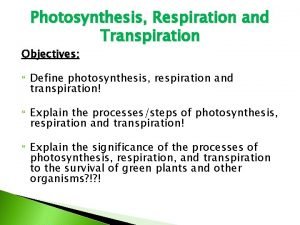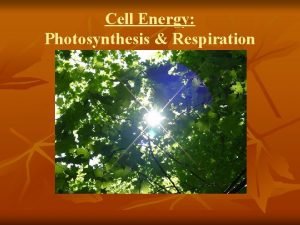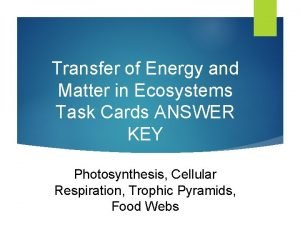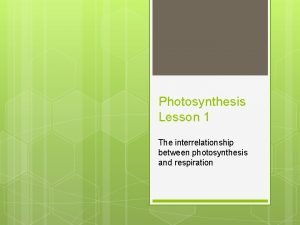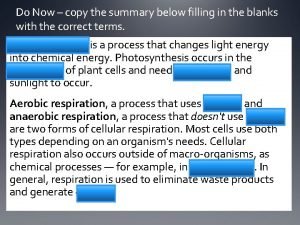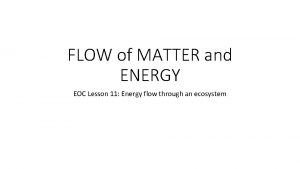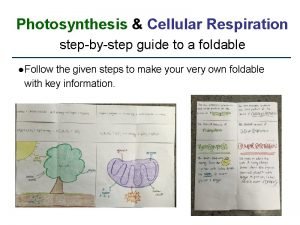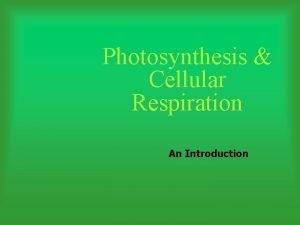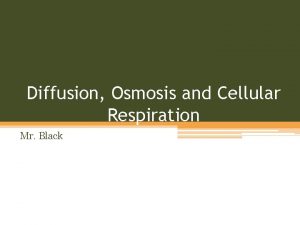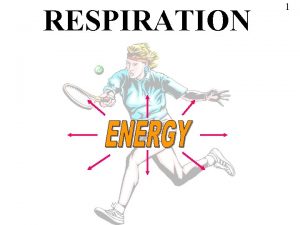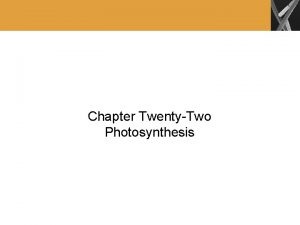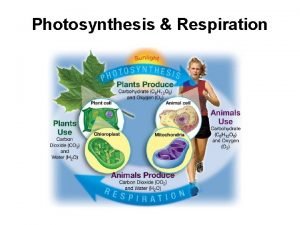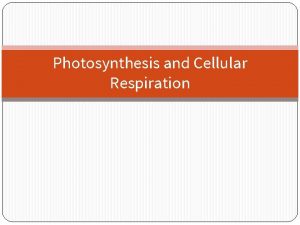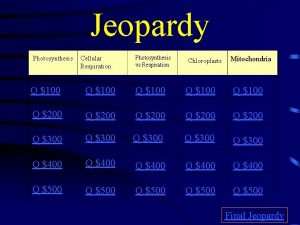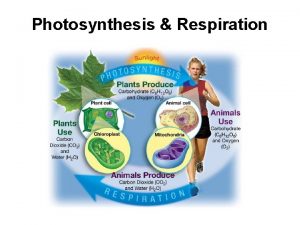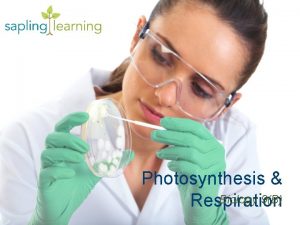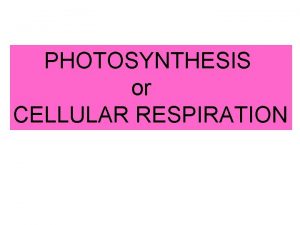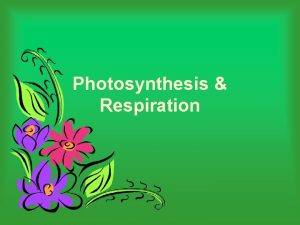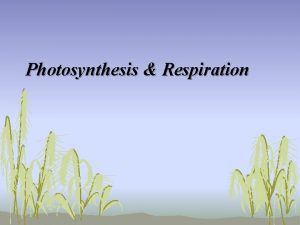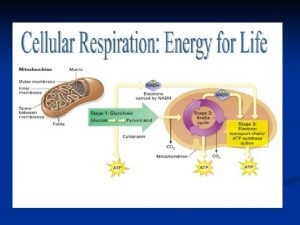Photosynthesis Respiration Photosynthesis Organisms that carry on photosynthesis
























- Slides: 24

Photosynthesis / Respiration

Photosynthesis Organisms that carry on photosynthesis are called autotrophs or producers. They contain chlorophyll inside cell organelles called chloroplasts. n Organisms that are not able to carry on photosynthesis are called heterotrophs and capture their food. They depend on plants directly or indirectly as their source of food. n

Pigments In order to capture sunlight, plants require special pigments. A pigment is any substance that can absorb light. Several types of pigments are necessary to trap the full light spectrum. These pigments consist of: n red, orange, yellow, green, blue, and violet n

Major Types of Pigments 1. Chlorophyll n - most important pigment n - present in the largest numbers compared to other pigments n - capture red and blue light while reflecting green n - green in color n

Photosynthesis 2. Carotene (orange in color) n 3. Xanthophylls (yellow in color) n Carotene and xanthophylls absorb light in regions of the light spectrum not covered by chlorophyll. n

Two Major Forms of Chlorophyll: (i) Chlorophyll A n This is the primary photosynthesis pigment. It directly converts light energy to chemical energy. n (ii) Chlorophyll B n Absorbs light energy and transfers it to chlorophyll A. n

Photosynthesis The process by which an organism captures the energy of the sun to convert CO 2 and water into glucose. n Radiant energy is converted into chemical energy. n The process looks as follows: n carbon dioxide + water n sunlight chlorophyll glucose + oxygen

This is an important process because: (1) It is the chief source of energy on earth. n (2) It supplies most of the oxygen found in the atmosphere. n (3) It is the first step in food chains. n

Stages of Photosynthesis Light Reaction n Requires light and takes place on the thylakoid membrane of the chloroplast. Chlorophyll captures the sun’s energy and uses it to produce oxygen and high energy compounds which are used in the dark reaction. n

Dark Reaction n Does not require light, but does depend upon the high energy chemical products made in the light reaction. n This reaction occurs in the stroma. n The reaction produces glucose and is often called carbon fixation. n

Overall Formula: n 6 CO 2 + 12 H 2 O chlorophyll light C 6 H 12 O 6 + 6 O 2 + 6 H 2 O

Rate of Photosynthesis Four factors control the rate: rate (1) Light Intensity - the greater the amount of light, the more photosynthesis occurs n (2) Temperature - below 0 o. C and above 35 o. C there is little photosynthesis n (3) Water - when in short supply, photosynthesis slows down n (4) Minerals - when in short supply, photosynthesis slows down n

Cellular Respiration This is the process of releasing energy, within a cell, through a complex series of chemical reactions. n It occurs at the mitochondria, and consists of the step-by-step breakdown of a nutrient, most commonly glucose, in order to release energy. n This energy is then stored in the cell in the form of ATP. n

The formation of ATP is important for two reasons: (1) the energy stored in glucose is not readily available to all cell parts, whereas ATP is. n (2) releases energy in the cell with greater control than if the energy came directly from glucose. n The ATP acts as the intermediary between energy-releasing (exergonic) and energyrequiring (endergonic) reactions in the cell. n

ATP Definition - high energy chemical compound found within cells n Structure - composed of a molecule of adenosine and three molecules of phosphate. The phosphates are held to the adenosine by high energy bonds. n A ---- P n High energy bonds

Cellular Respiration ATP is formed when energy released from the breakdown of glucose is used to add a phosphate to a molecule of ADP (adenosine diphosphate). n Function - ATP is the battery of the cell. It is the chief source of energy in the cell. Whenever the cell needs energy, a molecule of ATP is broken down and energy is released. n

ADP / ATP Cycle breakdown of glucose (energy in) +P ADP ATP -P cellular activity (energy out)

Forms of Cellular Respiration 1. Aerobic Respiration n - O 2 must be present n 2. Anaerobic Respiration n - O 2 not necessary n

1. Aerobic Respiration Definition - process by which glucose is completely oxidized into CO 2 and H 2 O in the presence of O 2 to release energy. n It is the most common form of glucose breakdown, and allows for the maximum amount of energy to be released from the glucose. n

Formula for aerobic respiration: C 6 H 12 O 6 6 O 2 (glucose) + (oxygen) 6 CO 2 (carbon dioxide) + + 6 H 2 O (water) 12 H 2 O (water) + 36 ATP (energy)

2. Anaerobic Respiration Definition - process by which glucose is broken down in the absence of oxygen to release energy. It creates little energy for the cell. It occurs in smaller organisms and in larger organisms when oxygen is not present. n Location - it occurs in the cytoplasm of plant and animal cells. n

There are two forms of anaerobic respiration: (A) Alcohol Fermentation: 2 C 2 H 5 OH C 6 H 12 O 6 (ethyl + (glucose) glucose alcohol) alcohol 2 CO 2 (carbon dioxide) dioxide (B) Lactic Acid Fermentation: C 6 H 12 O 6 (glucose) 2 C 3 H 6 O 3 (lactic acid)

Respiration Photosynthesis Respiration and photosynthesis are dependant upon each other. n Photosynthesis produces the raw materials for respiration, and respiration produces the raw materials for photosynthesis. n

CO 2 + H 2 O (light) Photosynthesis glucose O 2 Respiration ATP
 External respiration
External respiration External respiration
External respiration Why do organisms interact with other organisms
Why do organisms interact with other organisms Unicellular and multicellular
Unicellular and multicellular Phân độ lown
Phân độ lown Walmart thất bại ở nhật
Walmart thất bại ở nhật Gây tê cơ vuông thắt lưng
Gây tê cơ vuông thắt lưng Block nhĩ thất độ 1
Block nhĩ thất độ 1 Tìm độ lớn thật của tam giác abc
Tìm độ lớn thật của tam giác abc Sau thất bại ở hồ điển triệt
Sau thất bại ở hồ điển triệt Thơ thất ngôn tứ tuyệt đường luật
Thơ thất ngôn tứ tuyệt đường luật Hãy nói thật ít để làm được nhiều
Hãy nói thật ít để làm được nhiều Thơ thất ngôn tứ tuyệt đường luật
Thơ thất ngôn tứ tuyệt đường luật Tôn thất thuyết là ai
Tôn thất thuyết là ai Describe photosynthesis
Describe photosynthesis Equation of cellular respiration
Equation of cellular respiration Photosynthesis and cellular respiration jeopardy
Photosynthesis and cellular respiration jeopardy How do plants get glucose
How do plants get glucose Where does cellular respiration take place
Where does cellular respiration take place Interrelationship between photosynthesis and respiration
Interrelationship between photosynthesis and respiration Venn diagram photosynthesis and respiration
Venn diagram photosynthesis and respiration Photosynthesis or cellular respiration
Photosynthesis or cellular respiration Photosynthesis and cellular respiration foldable
Photosynthesis and cellular respiration foldable The chemical process of photosynthesis
The chemical process of photosynthesis The warm up osmosis
The warm up osmosis














